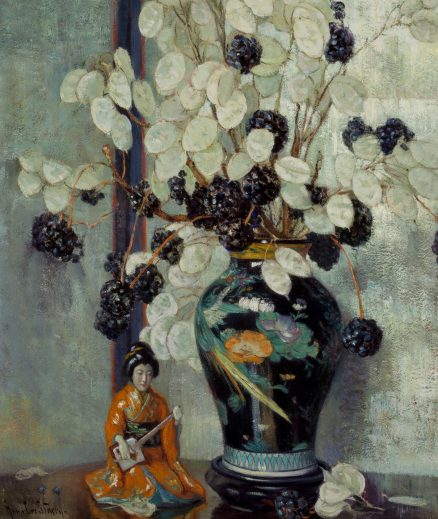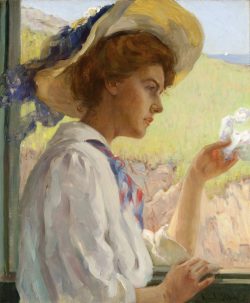- Categories
- Still lifes
- Women artists
- Zoom in on Artwork
- Print Page
- Email Page to Friend
Anna Stacey’s Chinese Jar evokes the exotic East in its assortment of elegant objects. The elaborate ceramic jar or vase on a carved wood stand is decorated with images of water-lilies and a pheasant on a black background. It holds an unusual mixture of plants: the dried oval seed pods of the money plant (lunaria) and shiny dark-blue berries on reddish stalks. Sharing the polished tabletop is a statuette of a kimono-clad kneeling female figure holding a shamisen, a traditional Japanese stringed instrument with a distinctive square body. The backdrop to these objects appears to be a folding screen. Two of its panels meet in a vertical band of blue and red that gives the composition a decidedly asymmetrical emphasis. Strong contrasts of almost monochromatic darks and lights set off the bright tints of the figurine and the vase.
For much of her long career, Stacey exhibited mostly genre scenes and landscapes in the Art Institute of Chicago’s annual exhibitions. In the early 1920s she began to also paint still-life images; these dominated the works she showed in her joint exhibition with her husband, landscape painter John F. Stacey, at Chicago’s Carson Pirie Scott and Company department store in 1928. Anna Stacey’s titles typically name the floral subjects of her still-life paintings, but Chinese Jar, the title of a painting she showed in the Art Institute’s 1924 “Chicago and Vicinity” exhibition, is an exception. With it, Stacey drew attention to the exquisite man-made vessel rather than the plants it bears, thereby partaking in an established fashion for all things “Oriental.”
Wendy Greenhouse, PhD
Donated by M. Christine Schwartz to the Florence Griswold Museum, Old Lyme, Connecticut, in 2021

